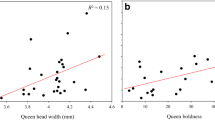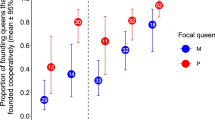Summary
We investigated the process of sexual maturation in winged queens of the fire ant Solenopsis invicta, a species with two distinct forms of social organization. We found that queens of the monogynous social form (single reproductive queen per colony) differ little or not at all from queens of the polygynous form (multiple reproductive queens per colony) in weight and fat content when these are pupae or newly-eclosed adults. Furthermore, the size of a sclerotized region of the adult thorax, which is set during larval growth, does not differ between queens of the two forms. In contrast, winged queens of the two social forms differ dramatically in their physiological phenotypes once they have matured, with monogynous queens weighing more and having greater fat reserves than polygynous queens. A crossfostering experiment revealed that the different maturation processes of queens of the two forms are induced largely by the type of colony in which a queen matures (monogynous or polygynous) rather than being due to intrinsic genetic differences between the forms. However, genetic variation at a single locus does appear to play some role in determining physiological phenotype in queens of the polygynous form, providing an example of genotype-environment interaction in the expression of these physiological traits. Differences between the social forms in the mature phenotypes that are produced constrain the reproductive options of queens, so that the characteristic social organization of a colony is perpetuated by virtue of the social environment in which new queens are reared.
Similar content being viewed by others
References
Barker JF (1978) Neuroendocrine regulation of oocyte maturation of the IFA, Solenopsis invicta. Gen Comp Endocrinol 35:234–237
Barker JF (1979) Endocrine basis of wing casting and flight muscle histolysis in the fire ant Solenopsis invicta. Experientia 35:52–55
Barth RH, Lester LJ, Sroka P, Kessler T, Hearn R (1975) Juvenile hormone promotes dominance behavior and ovarian development in social wasps (Polistes annularis). Experientia 31:691–692
Bohm M (1972) Effects of environment and juvenile hormone on ovaries of the wasp Polistes metricus. J Insect Physiol 18:1875–1883
Boomsma JJ (in press) Sex ratio variation in ants. In: Keller L (ed) Queen number and sociality in insects. Oxford University Press, Oxford
Bradshaw AD (1965) Evolutionary significance of phenotypic plasticity in plants. Adv Genet 13:115–155
Elmes GW, Keller L (in press) Distribution and ecology of queen number in ants of the genus Myrmica. In: Keller L (ed) Queen number and sociality in insects. Oxford University Press, Oxford
Fletcher DJC (1986) Triple action of queen pheromones in the regulation of reproduction in fire ant (Solenopsis invicta) colonies. In: Porchet M, Andries J-C, Dhainaut A (eds) Advances in invertebrate reproduction, 4. Elsevier, Amsterdam, pp 305–316
Fletcher DJC, Blum MS (1981) Pheromonal control of dealation workers in colonies of social insects. Science 219:312–314
Fletcher DJC, Blum MS (1983a) The inhibitory pheromone of queen fire ants (Solenopsis invicta): effects of disinhibition on dealation and oviposition by virgin queens. J Comp Physiol A 153:467–476
Fletcher DJC, Blum MS, Whitt TV, Tempel N (1980) Monogyny and polygyny in the fire ant Solenopsis invicta Buren. Ann Entomol Soc Am 73:658–661
Glancey BM, Lofgren CS (1988) Adoption of newly-mated queens: a mechanism for proliferation and perpetuation of polygynous red imported fire ants, Solenopsis invicta Buren. Fla Entomol 71:581–587
Glancey BM, Vandenburhg MK, St Romain MK (1976) Testes degeneration in the red imported fire ant, Solenopsis invicta. J Ga Entomol Soc 2:83–88
Greenberg L, Fletcher DJC, Vinson SB (1985) Difference in worker size and mound distribution in monogynous and polygynous colonies of the fire ant Solenopsis invicta Buren. J Kans Entomol Soc 58:9–18
Hildebrandt HH, Kaatz H-H (1990) Inpact of queen pheromone on the physiological status of worker honey bees (Apis mellifera L.) In: Veeresh GK, Mallik B, Viraktamath CA (eds) Social insects and the environment. Oxford and IBH Publishing, New Delhi, pp 740–741
Hölldobler B, Wilson EO (1977) The number of queens: an important trait in ant evolution. Naturwissenschaften 64:8–15
Hölldobler B, Wilson EO (1990) The Ants. Harvard University Press, Cambridge
Huxley JS (1932) Problems of relative growth (reprinted 1972). Dover, New York
Jouvenaz DP, Allen GE, Banks WA, Wojcik DP (1977) A survey for pathogens of fire ants, Solenopsis spp. in the southeastern United States. Fla Entomol 60:275–279
Kaatz H-H, Hildebrandt H, Engels W (1992) Primer effect of queen pheromone on juvenile hormone biosynthesis in adult worker honey bees. J Comp Physiol (B) 162:588–592
Keller L (1991) Queen number, mode of colony founding and queen reproductive success in ants (Hymenoptera Formicidae). Ethel Ecol Evol 4:307–316
Keller L (1993) The assessment of reproductive success of queens in ants and other social insects. Oikos 67:177–180
Keller L (ed) (in press) Queen number of sociality in insects. Oxford University Press, Oxford
Keller L, Nonacs P (1993) The role of queen pheromones in colonies of social insects; queen control or queen signal? Anim Behav 45:787–794
Keller L, Passera L (1989) Size and fat content of gynes in relation to the mode of colony founding in ants (Hymenoptera; Formicidae). Oecologia 80:236–240
Keller L, Passera L (1990) Queen number, social structure, reproductive strategies and their correlates in ants. In: Veeresh GK, Mallik B, Viraktamath CA (eds) Social insects and the environment. Oxford and IBH Publishing, New Delhi, pp 236–237
Keller L, Passera L (1992) Mating system, optimal number of matings, and sperm transfer in the Argentine ant Iridomyrmex humilis. Behav Ecol Sociobiol 31:359–366
Keller L, Ross KG (1993) Phenotypic basis of reproductive success in a social insect: genetic and social determinants. Science 260:1107–1110
Keller L, Vargo EL (in press) Reproductive structure and reproductive roles in colonies of eusocial insects. In: Keller L (ed) Queen number and sociality in insects. Oxford University Press, Oxford
Markin GP, Collins HL, Dither JH (1972) Colony founding by queens of the red imported fire ant, Solenopsis invicta. Ann Entomol Soc Am 65:1053–1058
Michener CD (1974) The social behavior of bees: a comparative study. Harvard University Press, Cambridge
Moran NA (1992) The evolutionary maintenance of alternative phenotypes. Am Nat 139:971–989
Pamilo P, Rosengren R (1984) Evolution of nesting strategies of ants: genetic evidence from different population types of Formica ants. Biol J Linn Soc 21:331–348
Passera L (1984) L'organisation sociale chez les fourmis. Univ PaulSabatier Press, Toulouse
Passera L, Keller L (1990) Loss of mating flight and shift in the pattern of carbohydrate storage in sexuals of ants (Hymenoptera, Formicidae). J Comp Physiol B 160:207–211
Passera L, Keller L (1992) The period of sexual maturation and the age at mating in Iridomyrmex humilis, an ant with intranidal mating. J Zool London 228:141–153
Porter SD (1991) Origins of new queens in polygyne red imported fire ant colonies (Hymenoptera:Formicidae). J Entomol Sci 26:474–478
Porter SD (1992) Frequency and distribution of polygyne fire ants (Hymenoptera:Formicidae) in Florida. Fla Entomol 75:248–257
Porter SD, Van Eimeren B, Gilbert LE (1988) Invasion of fire ants (Hymenoptera, Formicidae): microgeography and competitive replacement. Ann Entomol Soc Am 81:777–781
Rosengren R, Sundstöm L, Fortelius W (in press) Monogyny and polygyny in Formica ants: a result of alternative dispersal tactics? In: Keller L (ed) Queen number and sociality in insects. Oxford Univ Press, Oxford
Ross KG (1992) Strong selection on a gene that influences reproductive competition in a social insect. Nature 355:347–349
Ross KG (1993) The breeding system of the fire ant Solenopsis invicta: effects on colony genetic structure. Am Nat 141:554–576
Ross KG, Fletcher DJC (1985) Comparative study of genetic and social structure in two forms of the fire ant Solenopsis invicta (Hymenoptera:Formicidae). Behav Ecol Sociobiol 17:349–356
Ross KG, Matthews RW (eds) (1991) The social biology of wasps. Cornell University Press, Ithaca
Ross KG, Shoemaker DD (in press) An unusual pattern of gene flow between the two social forms of the fire ant Solenopsis invicta. Evolution
Ross KG, Vargo EL, Fletcher DJC (1987) Comparative biochemical genetics of three fire ant species in North America, with special reference to the two social forms of Solenopsis invicta (Hymenoptera:Formicidae). Evolution 41:979–990
Sokal RR, Rohlf FJ (1982) Biometry: the principles and practice of statistics in biological research (2nd edn). Freeman, San Francisco
Sorensen AA, Fletcher DJC, Vinson SB (1985) Distribution of inhibitory queen pheromone among virgin queens of an ant, Solenopsis invicta. Psyche 92:57–69
Stearns SC (1989) The evolution and significance of phenotypic plasticity. BioScience 39:436–445
Strambi A (1990) Physiology and reproduction in social wasps. In: Engels W (ed) Social insects: an evolutionary approach to castes and reproduction. Springer, Berlin, pp 59–75
Trivers RL, Hare H (1976) Haplodiploidy and the evolution of the social insects. Science 191:249–263
Tschinkel WR, Howard DF (1983) Colony founding by pleometrosis in the fire ant, Solenopsis invicta. Behav Ecol Sociobiol 12:103–113
Vargo EL (1992) Mutual pheromonal inhibition among queens in polygyne colonies of the fire ant Solenopsis invicta. Behav Ecol Sociobiol 31:205–210
Vargo EL, Fletcher DJC (1986) Evidence of pheromonal queen control over the production of male and female sexuals in the fire ant, Solenopsis invicta. J Comp Physiol A 159:741–749
Vargo EL, Fletcher DJC (1989) On the relationship between queen number and fecundity in polygynous colonies of the fire ant, Solenopsis invicta. Physiol Entomol 14:223–232
Vargo EL, Passera L (1991) Pheromonal and behavioral queen control over the production of gynes in the Argentine ant Iridomyrmex humilis (Mayr). Behav Ecol Sociobiol 28:161–169
Vargo EL, Porter SD (1989) Colony reproduction by budding in the polygyne form of the fire ant, Solenopsis invicta (Hymenoptera: Formicidae). Ann Entomol Soc Am 82:307–313
Voss SH (1981) Trophic egg production in virgin fire ant queens. J Ga Entomol Soc 16:437–440
Ward PS (1989) Genetic and social changes associated with ant speciation. In: Breed M, Page RE (eds) The genetics of social evolution. Westview, Boulder, pp 123–148
West-Eberhard MJ (1986) Alternative adaptations, speciation and phylogeny (a review). Proc Natl Acad Sci USA 83:1388–1392
West-Eberhard MJ (1989) Phenotypic plasticity and the origins of diversity. Annu Rev Ecol Syst 20:249–278
Wheeler DE (1991) The developmental basis of worker caste polymorphism in ants. Am Nat 138:1218–1238
Wilson EO (1971) The insect societies. Harvard University Press, Cambridge
Author information
Authors and Affiliations
Additional information
Correspondence to: L. Keller
Rights and permissions
About this article
Cite this article
Keller, L., Ross, K.G. Phenotypic plasticity and “cultural transmission” of alternative social organizations in the fire ant Solenopsis invicta . Behav Ecol Sociobiol 33, 121–129 (1993). https://doi.org/10.1007/BF00171663
Received:
Accepted:
Issue Date:
DOI: https://doi.org/10.1007/BF00171663




